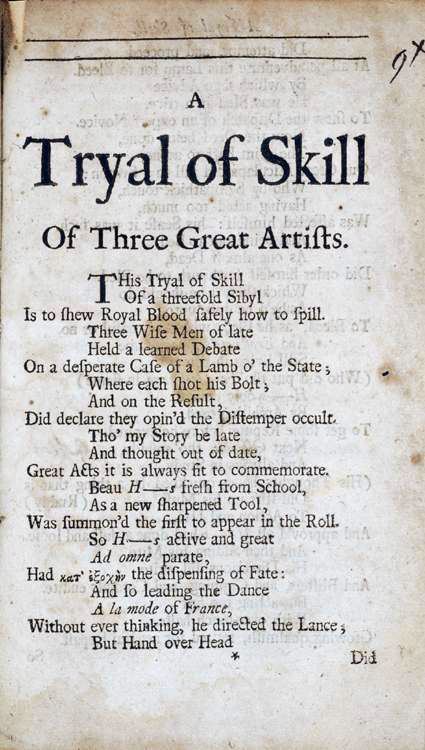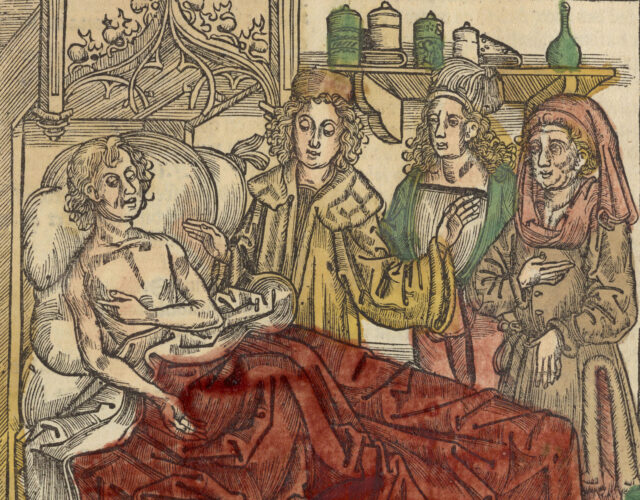On the night of February 1, 1685, King Charles II went to bed at Whitehall Palace in London with a sore foot. The next morning he could barely speak, and while a servant tried to shave him, he collapsed—rendered temporarily unconscious by a seizure. Within hours more than a dozen doctors from the Royal College of Physicians arrived at the palace. One physician slashed the king’s arm open with a knife, taking 16 ounces of blood. Others fed him a raft of different concoctions, including one made from ground-up human skulls. Doctors administered enema after enema to purge Charles’s stomach and bowels, and then burned the king with scalding hot cups and irons that left his body covered in blisters. The remedies continued until the king died on February 6, 1685.
Such treatments may strike us today as torturous, but for the king’s doctors these practices were standard. Like other 16th- and 17th-century physicians trained at elite universities, these men followed the teachings of ancient Greek philosophers, including Aristotle and Galen of Pergamon, who lived in the 2nd century. Galenics, as these doctors called themselves, believed that human health was dictated by the balance and imbalance of four bodily fluids—yellow bile, black bile, blood, and phlegm—known as humors. Much earlier Hippocrates, a Greek physician, had applied the theory of four elements (air, fire, water, earth) to human health by assigning each one to a bodily fluid; Galen expanded this theory into the humors. When a person took ill, the Galenics believed a cure could be found by rebalancing the humors through diet and exercise, as well as through bleedings, burnings, and enemas.
In the 16th and 17th centuries many thinkers began to question received knowledge, turning instead to observation and experimentation. One such man was Jan Baptista van Helmont, a Flemish natural philosopher who believed Galen—and thus the Galenics—had gotten things wrong. Unlike his Galenic counterparts, van Helmont refused to rely on theoretical reasoning or ancient authorities and instead approached illness with empiricism. He discovered that chemical reactions could produce substances that were neither solids nor liquids and coined the term gas to describe them. (Robert Boyle based much of his research on gases on van Helmont’s work.)
Van Helmont’s gases were capable of transmitting disease and were unaffected by Galenical treatments; furthermore, he believed that external forces of disease, such as those carried by gases, interacted with a spiritual entity within the body that regulated bodily functions. Illness occurred when this governing agent was weak, and medical remedies sought to strengthen it so that the body could expel the disease. Rather than the four fluctuating humors, van Helmont argued that only one element formed the basis of life—water—and offered skeptics a demonstration. He put a plant in an earth-filled pot after carefully measuring the weight of plant and soil. The plant was given only water, yet several years later van Helmont found its weight had increased while the weight of the dirt had stayed the same, seemingly proving that the plant only needed water to grow. Van Helmont challenged Galenics to prove the existence of their humors with similar experiments, but they never took the challenge seriously.
Religious zeal powered van Helmont’s medical crusade, and he wielded scripture as a weapon against his adversaries. He found justification for his beliefs in chapter 38 of the apocryphal book Ecclesiasticus, which includes the lines “the Lord created medicines from the earth, and a sensible man will not despise them.” Van Helmont interpreted such words to mean the role of a physician was ordained by God. He would spend the rest of his life trying to convince the world that he was one of those uniquely qualified healers. In van Helmont’s assessment, Galenics, with their heathen Greek ideas, were nothing but frauds.
A few years after van Helmont’s death in 1644, his son published a collection of his work, Ortus Medicinæ (Origin of Medicine), which quickly gained a following in England during the Civil Wars and their aftermath. Followers of van Helmont’s teachings called themselves Helmontians and rallied to put an end to what they believed were barbaric Galenic practices, which they associated with the oppressive rule of the Royalists. Two of the most prominent Helmontians were Thomas O’Dowde, an Irish physician and apothecary, and George Thomson, a physician and medical writer. In treating illnesses they offered chemical remedies rather than the Galenics’ knives and purges. The sophistication of such medicines was far from that of today’s pharmaceuticals—ingredients included mercury, acids, and alkalis—and ironically many of these chemicals produced unintentional purging.

In their battle against Galenics, Helmontians produced satirical pamphlets, books, and public lectures. One polemical poem in the Institute’s Othmer Library, “A Tryal of Skill of Three Great Artists,” shows the creativity used by Helmontians in their attacks on Galenics. Details in the anonymous poem bear a startling resemblance to the circumstances of Charles II’s death: three inept physicians, impaired by “Ignorance, Madness, or Wine,” bleed a royal patient to death and then try to cover their tracks. While this skewering resonated with like-minded peers who tinkered with experimentation at the Royal Society and homemade laboratories, the battle to win over the average man or woman was fought at England’s bedsides and was far less successful.
The Helmontians were up against more than a millennium of entrenched beliefs about medicine and disease. Popular belief was shaped by watching doctors treat sick family and friends. Disease and healing were inextricably linked with pain, suffering, and expulsion of bodily fluids. How could they know they were rid of a disease without seeing it leave their body? When a physician, Galenic or Helmontian, was called to treat a patient, that person’s friends and family—and often the patient herself—demanded there be bleeding and purging.
Faced with resistance from patients and from doctors at the Royal College of Physicians, a handful of Helmontians, including O’Dowde and Thomson, began to write what we might now call case studies to show the effectiveness of their treatments and to promote their work. The obstacles Helmontians faced are apparent in these works, such as a study Thomson published in 1668 on a patient who enlisted the help of two physicians, one Helmontian (Thomson) and one Galenic. Thomson squabbled with his Galenic counterpart over proper treatments, and each doctor tried to sneak medicine to the patient without the other knowing. Thomson was eventually dismissed from the bedside after being accused of administering medicine that was too “hot” and “violent.”After the patient made a full recovery, Thomson wrote that his medicine was to thank but that the Galenic physician had carried away “the credit of the Cure.”
Other Helmontians adapted to their patients’ stubbornness by combining pharmaceutical treatments with conventional remedies. In The Poor Man’s Physician, Or the True Art of Medicine (1665), O’Dowde recounts how he compromised with patients, most of whom asked for Galenic-style purging in addition to chemical medicines. O’Dowde describes treating one patient with “at least 200 vomits and 100 odd stools” over the course of a month.
Many of O’Dowde’s colleagues were reluctant to compromise on their beliefs, but ultimately the Helmontians who incorporated Galenic methods into their practices prospered while Helmontians who refused to do so failed. Some Galenics were willing to make use of new chemical discoveries and experiments as long as they could fit them into their medical philosophy. The result was a slight shift rather than a radical change in the practice of medicine; throughout the next century traditionally trained physicians were more willing to test their theories before putting them into practice, but classification and treatment of disease remained largely the same until the 19th century, when Louis Pasteur and others showed that tiny organisms caused disease.
By the time “A Tryal of Skill” was published in 1699, Charles was long dead, and the Helmontians had lost their war with the Galenics, which may be why the author apologizes for the poem’s tardiness:
And thought out of date,
Great Acts it is always fit to commemorate.




